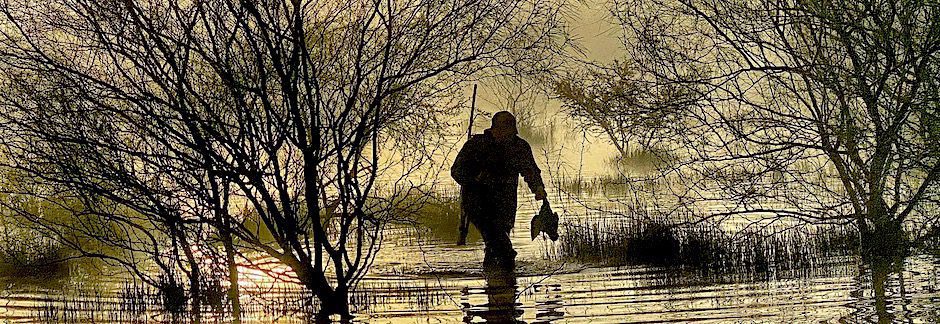MOJO’S Duck Season Somewhere Podcast
EP 328. All About the Show at Strait Lake

“It’s all about the show,” explains Strait Lake Lodge owner Max Sharp about greenheads in the timber. Strait Lake is Sharp’s build-it-and-they-will-come Arkansas duck camp, the culmination of a lifetime chasing ducks. We talk about his duck hunting origins to include old school outdoors, his vision for Strait Lake, what all goes into creating ideal habitat, and long-term conservation ideals. It really is all about the show.
EP 327. Breaking Bread with Chef John

Chef John Fearrington knows his way around hunting camp kitchens, that’s for danged sure. A powerful and articulate storyteller, he describes strong family ties and mom’s home-cooking nourishing his body, mind, and soul, giving him a profound sense of community and sending him on a colorful life journey from the deep inner city to Strait Lake Lodge, Arkansas– and beyond. Great conversation fodder that you’ll chew on for a good long while.
EP 326. While Duck Hunting Beaver Dam Lake, Mississippi

Towards the end of an epic, old school duck hunt in historic Beaver Dam Lake’s Clover Hole, Mississippi, Ramsey chats with hunting companions Mike and Lamar Boyd, Dale Bordelon and John Gordon. What’s the historical significance of this lake and duck blind location? What does hunting here mean to everyone and how’d they pay tribute to its storied past? And there’s a first for everything, even while recording Duck Season Somewhere podcast. Tune in to find out!
EP 325. Illinois River Duck Hunting Club

Originally founded in 1883 as the Hennepin Duck Club, Willow Creek has a long-standing and storied history in the fabled Illinois River bottom. So does the camphouse. Preston Wagner, Pete Mangold and Adrian Erickson each describe their personal connections to this Illinois River duck hunting club. From habitat management to new and lifetime memories, their unique perspectives characterize a real sense of place.
EP 324. Retriever Health

Following an action-packed Mississippi duck hunt and with black labs dozing contentedly at our feet, long-time friend and life-long waterfowler, Dr. Bill Sullivan, discusses the health and maintenance of our beloved duck dogs. Having practiced veterinarian medicine for decades covers a lot of need-to-know topics for ensuring our best friends’ peak performance, long-term health and longevity while doing what they were born to do.
ep 323. IL River Decoys

Located on the river about half-way between Chicago and St. Louis, Peoria is the oldest European settlement in Illinois. Preceding the Migratory Bird Treaty Act market hunting thrived. Its history is seeped in Mississippi Flyway waterfowl hunting history as expressed by some of the most collectible decoys on earth. Zac Zetterburg, Curator of Art and the Center for American Decoys, Peoria Riverfront Museum, discusses the region’s history and legendary carvers, explaining along the way how carvings intended for hunting became collectible folk art.
Related Links:
EP 322. Eastern Shore Waterman, Brian Terry

Brian Terry grew up plying his family’s fourth-generation oyster trade around Hog Island Bay, Virginia. Anything but easy work, he somehow managed to duck hunt, too, and that eventually lead to a related product development in response to his family’s tough-love company hiring policy. Describing how and why his great-great-grandfather founded H.M. Terry Company, he gives us a salty crash course in clamming and oystering, explaining once and for all why you never, ever eat oysters in months ending with the letter R!
Related Links:
EP 321. Chesapeake Decoy Carving Family Tradition

Charlie Pierce has been among hand-sawn woodpiles, sawdust, oil paints since the day he was born, and grew up sharing duck blinds with some of the region’s most esteemed carvers. Naturally, it’s in his blood. A colorful storyteller, Pierce describes growing up in this unique environment, telling how and what they hunted, the decoys used, and how those old school influences lead him to carrying on a family tradition.
EP 320. Chesapeake Bay Lore and Legends

Ramsey meets with Chesapeake Bay waterfowling historian and preservationist, C. John Sullivan, at the Waterfowl Festival in Easton, Maryland to larne about this region’s fabled history. From market hunting tools-of-the-trade to legendary carvers, we gain insights into why the Chesapeake Bay’s history is so well preserved and, in a sense, who we are as duck hunters.
Related Links:
EP 319. Old School Havre de Grace Decoy Carver, Jim Pierce

He’s an absolute living legend. Jim Pierce has been carving decoys and hunting ducks near Havre de Grace, Maryland for 75 years of his 88 years. In a candid then-versus-now conversation in his decoy painting room, he talks about his lifetime duck hunting the Chesapeake Bay, describing the legendary watermen that taught him to hunt and to carve, the “good old days,” old shotguns, plastic versus wooden decoys, how hunting techniques and other things have changed for better or for worse. But best I can tell, the one thing that definitely has not changed is what duck hunting really means to him!




















